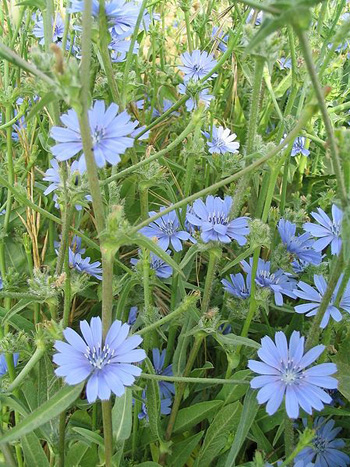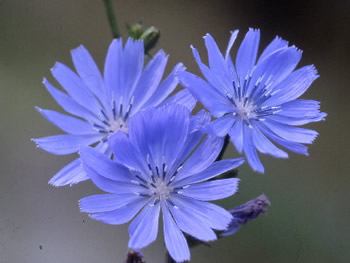Contents:
Common Names | Parts Usually Used | Plant(s) & Culture | Where Found | Medicinal Properties
Legends, Myths and Stories | Uses | Formulas or Dosages | How Sold | Bibliography
Scientific Names

- Cichorium intybus L.
- Compositae
- Composite family
Common Names
- Endive
- Garden chicory
- Garden endive (Cichorium endive)
- Succory
- Wild chicory
- Wild succory
- Blue dandelion
Parts Usually Used
Rootstock, flowering herb
Back to Top

Description of Plant(s) and Culture
A perennial or biennial plant 2-4 feet tall; the large taproot; light yellow outside, white inside, and, like the rest of the plant, contains a bitter, milky juice. The stiff, roughly hairy, angular, branching stem bears lanceolate leaves that are coarsely wavy, toothed near the bottom of the plant but entire higher up. The light-blue to violet-blue, axillary or terminal flowerheads in small clusters in upper leaf axils, feature rays that are toothed at the ends. They open in the morning. Flowering time is from July to September or October. Seeds are pale brown.
Back to Top
Where Found
Commonly cultivated and also are a common sight wild, along roadsides, in vacant lots, waste ground, and fields throughout the United States and Europe. Most of the United States cultivated Chicory is grown in Michigan State.
Back to Top
Medicinal Properties
Appetizer, astringent, carminitive, cholagogue, digestive, diuretic, hepatic, laxative, tonic.
Back to Top
Legends, Myths and Stories
It would surprise many farmers to know that this weed, so common in barnyards and along waysides, was a highly regarded medicine of the ancient Egyptian and Arabian physicians. The plant was very common over most of Europe before America was discovered, and is still much used by people of modern times. The blanched leaves are used in salads; the baked roots as pottage, and pulverized dried roots of Chicory was used to give body to coffee, or as a coffee substitute.
Roasted chicory roots may be used as a substitute for coffee and the young leaves eaten in salads. Chicory is used as an additive to coffee. The French are particularly fond of chicory in coffee.
Roasted chicory not only cuts down the caffeine content of coffee, but also gives coffee body and smoothness, which millions of coffee drinkers prefer. When adulterating Roasted Chicory with coffee, begin with a small amount; add more to subsequent mixtures until you acquire the most desirable mixture. Naturally the more Roasted Chicory used, the less caffeine you will get.
At one time, this was a disreputable adulterant in coffee; but by skillful roasting methods it has become an esteemed ingredient in New Orleans type coffee. Roasted Chicory now deserves a niche of its own as a flavor in the culinary world. For a delightful and wholesome difference, heat (do not boil) 1 cup of milk, add 1 tsp. (or more if desired) of roasted chicory; steep 5 to 10 minutes. Strain and sweeten to taste. The flavor of this beverage is very much like a milk chocolate. This beverage leaves no caffeine jitters, and contains no theobromine (as in cocoa) that sometimes causes digestive disturbance.
Back to Top
Uses
Chicory is often helpful for jaundice and for spleen problems. The juice of the leaves and a tea made from the flowering plant promote the production of bile, the release of gallstones, and the elimination of excessive internal mucus. They are also useful for gastritis, lack of appetite, and digestive difficulties. AA decoction of the rootstock is said to be helpful to the glandular organs or the digestive system. For painful inflammations, try applying the boiled leaves and flowers wrapped in a cloth. Also a spring tonic.
One ounce root in 1 pint of water used as a diuretic, laxative, folk use for jaundice, skin eruptions, slightly sedative, and mildly laxative. Homeopathically used for liver and gall bladder ailments. Leaf extracts weaker than root extracts. In experiments, animals given chicory root extracts exhibit a slower and weaker heart rate (pulse). It has been suggested that the plant should be researched for use in heart irregularities. Root extracts in alcohol solutions have proven anti-inflammatory effects in experiments.
Back to Top
Formulas or Dosages
Gather the rootstock from March to May.
Decoction: use 1 tsp. rootstock or herb per 1/2 cup of cold water; bring to a boil and strain. Take 1 to 1 1/2 cups per day, a mouthful at a time.
Juice: take 1 tbsp. in milk or water, 3 times per day.
Back to Top
How Sold
Found in most supermarkets
Back to Top
Bibliography
![]() The Herb Book
The Herb Book, by John Lust, Bantam Books, 666 Fifth Avenue, New York, NY. copyright 1974.
![]() Back to Eden
Back to Eden, by Jethro Kloss; Back to Eden Publishing Co., Loma Linda, CA 92354, Original copyright 1939, revised edition 1994
![]() Indian Herbalogy of North America
Indian Herbalogy of North America, by Alma R. Hutchens, Shambala Publications, Inc., Horticultural Hall, 300 Massachusetts Avenue, Boston, Massachusetts 02115, 1973
![]() The Herbalist Almanac
The Herbalist Almanac, by Clarence Meyer, Meyerbooks, publisher, PO Box 427, Glenwood, Illinois 60425, copyright 1988, fifth printing, 1994
![]() Chinese Medicinal Herbs
Chinese Medicinal Herbs, compiled by Shih-Chen Li, Georgetown Press, San Francisco, California, 1973.
![]() Eastern/Central Medicinal Plants
Eastern/Central Medicinal Plants, by Steven Foster and James A. Duke., Houghton Mifflin Company, 215 Park Avenue South, New York, NY 10000
![]() The Nature Doctor: A Manual of Traditional and Complementary Medicine
The Nature Doctor: A Manual of Traditional and Complementary Medicine, by Dr. H.C.A. Vogel; Keats Publishing, Inc., 27 Pine Street (Box 876) New Canaan, CT. 06840-0876. Copyright Verlag A. Vogel, Teufen (AR) Switzerland 1952, 1991
![]() The Complete Medicinal Herbal
The Complete Medicinal Herbal, by Penelope Ody, Dorling Kindersley, Inc, 232 Madison Avenue, New York, NY 10016, First American Edition, copyright 1993
 Old Ways Rediscovered
Old Ways Rediscovered, by Clarence Meyer, Meyerbooks, publisher, PO Box 427, Glenwood, Illinois 60425, published from 1954, print 1988
Herbal Gardening, compiled by The Robison York State Herb Garden, Cornell Plantations, Matthaei Botanical Gardens of the University of Michigan, University of California Botanical Garden, Berkeley., Pantheon Books, Knopf Publishing Group, New York, 1994, first edition
![]() Planetary Herbology
Planetary Herbology, by Michael Tierra, C.A., N.D., O.M.D., Lotus Press, PO Box 325, Twin Lakes. WI 53181., Copyright 1988, published 1992
![]() American Folk Medicine
American Folk Medicine, by Clarence Meyer, Meyerbooks, publisher, PO Box 427, Glenwood, Illinois 60425, 1973
![]() Webster’s New World Dictionary
Webster’s New World Dictionary, Third College Edition, Victoria Neufeldt, Editor in Chief, New World Dictionaries: A Division of Simon & Schuster, Inc., 15 Columbus Circle, New York, NY 10023
 An Instant Guide to Medicinal Plants
An Instant Guide to Medicinal Plants, by Pamela Forey and Ruth Lindsay, Crescent Books (January 27, 1992).
 The Rodale Herb Book: How to Use, Grow, and Buy Nature’s Miracle Plants (An Organic gardening and farming book)
The Rodale Herb Book: How to Use, Grow, and Buy Nature’s Miracle Plants (An Organic gardening and farming book), edited by William H. Hylton, Rodale Press, Inc. Emmaus, PA, 18049., 1974
![]() The Yoga of Herbs: An Ayurvedic Guide to Herbal Medicine
The Yoga of Herbs: An Ayurvedic Guide to Herbal Medicine, by Dr. David Frawley & Dr. Vasant Lad, Lotus Press, Twin Lakes, Wisconsin, Second edition, 1988.
